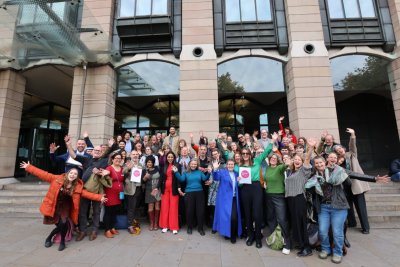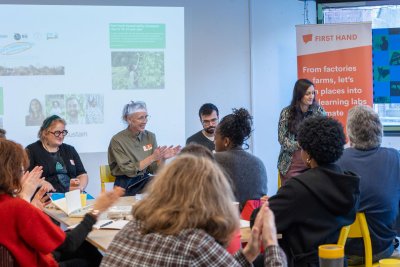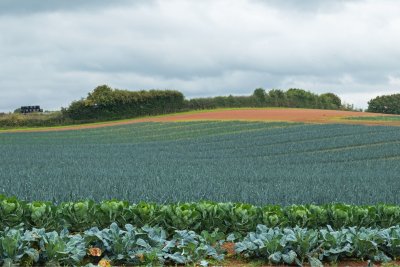 VideoThe legal team receiving a blessing in a ceremony led by Vey Straker as Lady Wye and Kim Kaos as Goddess of the Severn. Credit: River Action
VideoThe legal team receiving a blessing in a ceremony led by Vey Straker as Lady Wye and Kim Kaos as Goddess of the Severn. Credit: River Action
At the end of April, we went to court to challenge Shropshire Council’s approval of yet another huge intensive poultry unit. Our aim: to stop the unsustainable spread of factory farming across the county as part of River Action’s nationwide campaign to prevent further devastating river pollution from industrial agricultural practices.
The counties of Shropshire, Herefordshire and Powys are home to more than 50 million chickens at any one time, placing huge ecological pressures on the rivers Wye and Severn. The enormous quantities of manure produced by intensive livestock farming results in significant air and water pollution due to ammonia emissions and the deposition of nitrogen and phosphorus. For years, Shropshire Council has been approving application after application, allowing the significant expansion of intensive poultry units in the Severn catchment area. And, although measures outside the planning regime regulate certain activities that are carried out at poultry units (such as the spreading of manure on farmland), they have not been able to protect designated sites from the environmental impacts of manure. As the judge noted in the recent case of NFU v Herefordshire Council (in which River Action successfully intervened), non-planning measures have “beyond any doubt… failed to protect the environment from harm”.
Put simply, there are too many chickens located in precious and protected river catchments such as the Severn - causing ecological death by thousands of tonnes of chicken manure. My colleague Drew talks more about this problem in his blog.
The case we launched last week concerns the Council’s decision to grant permission for LJ Cooke & Son to build a unit housing 200,000 chickens in Felton Butler - right in the centre of the Severn catchment close to ecologically sensitive Ramsar sites and only 400 metres from an existing site holding nearly 500,000 birds - despite increasing concerns about the environmental impacts of this development and others like it.
We brought this legal challenge with River Action board member Dr Alison Caffyn to try to stop the new Felton Butler site. The case also has the potential to set a national precedent for how planning decisions are made by ensuring the environmental impacts of new intensive farms are properly assessed in combination with the impacts of existing ones. This is really important when the reality is that pollution extends beyond one individual agricultural development and impacts the wider area. A whole catchment approach to planning, management and enforcement is needed to address the issues facing our severely polluted rivers. This case seeks to develop the law and raise awareness to make the necessary systemic changes happen.
Before the hearing
Outside the legal process, we gathered early last Wednesday morning in front of the Cardiff Civil Justice Centre as part of River Action’s community-led demonstration - a visual representation of ‘too many chickens’ and an opportunity to bring the issues at the centre of the case to regional and national attention.
In a career first (but hopefully not last), I experienced a beautiful and moving water ceremony. A vial of water from the River Severn and the legal team were blessed in a ceremony led by Vey Straker as Lady Wye and Kim Kaos as Goddess of the Severn, with each of us choosing a word to describe a quality of the River Severn to evoke - with clarity, transparency, health, renewal and rebalance among those taken with us into the courtroom.
During the hearing
The two-day hearing involved complex legal arguments, with the judge asking detailed questions of counsel for each of the parties involved.
The case is a significant test of the legal principles governing environmental impact assessments (and, in particular, the assessment of indirect effects as recently considered in the cases of Squire and Finch), the use of planning conditions and the Habitats Regulations in the context of intensive livestock farming.
In court, David Wolfe KC representing Alison - with the vial of Severn water carefully placed on his desk - argued that Shropshire Council had failed to lawfully assess the effects of manure being taken off-site, acted unlawfully by imposing a condition which failed to prevent the spreading of manure on land and failed to carry out a lawful assessment of the development’s environmental impacts. He argued that a holistic approach needs to be taken to properly assess the cumulative effects and ecological damage of having many poultry units across the same river catchment.
In response, Shropshire Council and LJ Cooke & Son argued that impacts are controlled by the Farming Rules for Water (the regulatory regime found to be lacking in NFU v Herefordshire) and that the condition to take manure away to be processed on third-party land was required because the proposed new development was not large enough to handle the amount of manure that would be produced.
After the hearing
Whichever way the judgment goes (and judicial review cases are never easy to win), this case raises urgent and national-level questions: Should planning permission be granted for new factory farms near protected sites? Can local councils rely on promises from developers without enforceable safeguards or meaningful oversight? And are current environmental rules enough to protect our rivers from the proliferation of industrial-scale agriculture?
At the heart of this case is the crucial issue of whether environmental protections are being taken seriously in planning decisions — or whether councils long-term ecological risks are being undervalued in favour of short-term agricultural expansion. The outcome of this case could influence not only the fate of the Felton Butler site in Shropshire but also planning and environmental policy across the UK.
If the decision goes in our favour, councils will have more power to protect rivers from the growing pressures of agricultural pollution. This case could set a national precedent requiring more robust scrutiny of factory farming proposals - particularly in areas where multiple intensive livestock units operate within the same river catchment. It could also compel developers to produce more robust and enforceable waste management plans - building on the recent NFU v Herefordshire Council ruling, in which the High Court provided welcome clarification that livestock manure can be legally classified and treated as waste.
Some councils, like King’s Lynn and West Norfolk, are already rejecting factory farm proposals on environmental and climate grounds. I hope that this case will further empower councils to hold agricultural polluters to account. Now is the time to raise the bar for environmental protection - not lower it.
Following the hearing, Alison returned home to Shropshire - and the blessed vial of water to its rightful place in the River Severn.
A decision in this case is expected in the next few weeks. You can join River Action's mailing list to be kept up to date.
Food for the Planet: Helping local authorities to tackle the climate and nature emergency through food.








